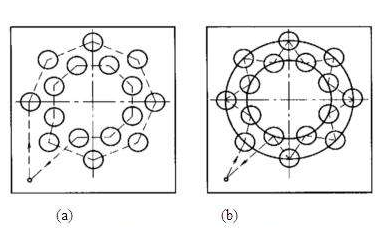How to Design CNC Machining Route? - CNC Machining Design Guide & CNC Machining Services Tips
What is CNC machining has been introduced in previous news on dajinprecision.com, then how to learn CNC machining and understand effective method? Programming design is the indispensable step to start the machining process. Here we introduces the CNC machining services China process tips and CNC machining design methods.
CNC Machining Services Process Control & Tips
Based on the possibility and convenience of programming, some contents should be noticed in CNC machining services China process.
1. Dimension marking should conform to the characteristics of CNC machining.
2. The conditions of geometric elements should be complete and accurate.
3. Reliable positioning datum.
4. Unified geometry type and size
CNC Machining Process Route Design
After selecting the content of CNC machining process and determining the processing route of parts, the CNC machining route can be designed. The main task of CNC machining design is to further determine the machining content, cutting parameters, process equipment, positioning and clamping mode and tool movement path of this process, so as to prepare for the machining program.
The problems of CNC machining process route design should pay attention to:
1. Division of process
According to the characteristics of CNC machining, the division of CNC machining process can be generally carried out according to the following methods.
(1) Take one-time installation and processing as one process
(2) Divide the working procedure according to the machining content of the same tool
(3) Divide by processing parts
(4) Divide by rough and finish machining
2. Arrangement of sequence
Generally, the sequence shall be arranged according to the following principles:
(1) The processing of the previous step shall not affect the positioning and clamping of the next step, and the processing procedure of universal machine tool inserted in the middle shall also be considered comprehensively;
(2) The inner cavity should be processed before the outside shape;
(3) For the process of machining with the same positioning and clamping method or with the same tool, it is better to process continuously, so as to reduce the times of repeated positioning, tool changing and pressing plate moving.
3. Connection between CNC processing technology and common manufacturing process
Before and after the CNC machining services, there are usually other common machining processes interspersed. If the connection is not good, the efficiency will be influenced. Therefore, it is necessary to familiar with the whole processing technology, and the technical requirements, processing purpose and processing characteristics of the CNC machining process and the general manufacturing process, such as machining allowance, the accuracy requirements, position tolerance, etc.
CNC Machining Services Route Design and Processing Sequence
The machine tool path is the movement track of the tool in the whole process. It not only includes the content of the work step, but also reflects the work step sequence. The cutting route is one of the bases of CNC programming. Tips for determining the tool path:
1. Seeking the shortest processing route, such as the (b).

2. The final contour is completed in one time.
3. Select cut in and cut out direction, the cutting out or cutting in point of the cutter should be on the tangent line along the contour of the CNC machining parts to ensure the smoothness of the workpiece.
4. Select the route to make the workpiece deform less after processing.
5. Determine the positioning and clamping programme.
(1) Design basis, process basis and programming calculation basis shall be unified as far as possible;
(2) Concentrate the process as much as possible, reduce the number of clamping, and process all surfaces to be processed after one clamping as much as possible;
(3) Avoid using the clamping plan with a long time of manual adjustment;
(4) The interaction point of the clamping force should fall on the position with better rigidity of the workpiece.
6. Determine the relative position of tool and workpiece, which is determined by confirming the tool setting point.
The selection principle of tool setting point:
(1) Make the programming simple;
(2) Select at the position easy to align and easy to determine the machining origin of parts;
(3) Select at a convenient and reliable position for inspection during machining;
(4) Conducive to improving the machining accuracy.
7. Determine the cutting amount.
When determining the cutting amount of each working procedure, the programmer should select it according to the durability of the tool and the provisions in the machine manual, it needs to fully ensure that the tool can finish machining a part, or the tool durability is not less than one work shift, at least not less than half of the work shift.
What is not ideal for CNC Machining?
With the CNC machining process, the product quality, production efficiency and comprehensive benefit have been improved obviously. In contrast, the following contents or situations are not suitable for CNC machining:
1. Too long adjustment time on CNC machine, for example, to locate the first fine datum with the rough datum of the blank, special tooling is needed to coordinate the contents.
2. The processing parts are scattered and need to be installed and set the origin for many times. At this time, it is very troublesome to use numerical control processing, and the effect is not obvious, general machine tools can be arranged for supplementary processing.
3. Profile machined according to some specific manufacturing basis, such as template, etc.
